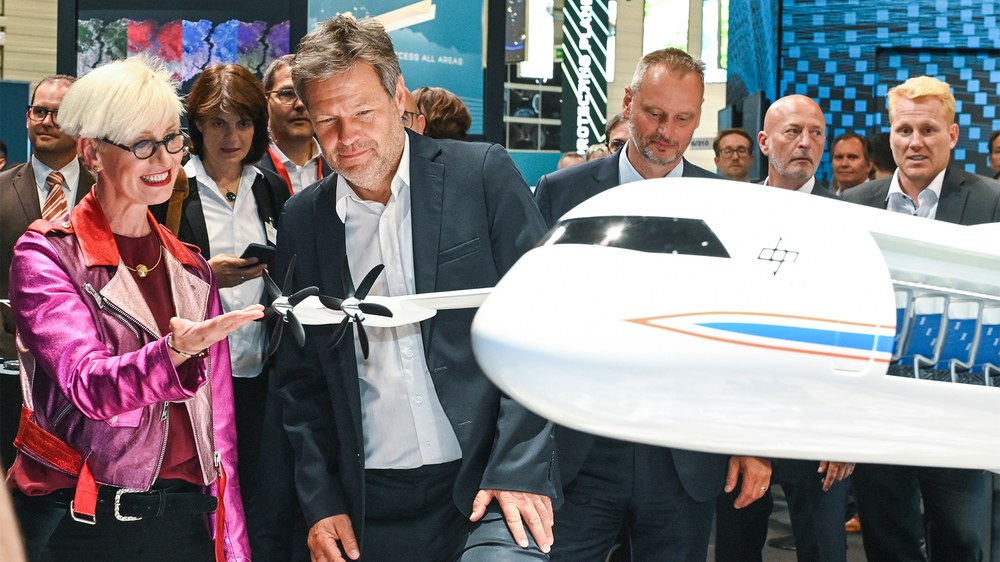Joint efforts by research and industry for climate-friendly air transport

- Approximately one third of the climate impact of air transport is accounted for by the much-discussed carbon dioxide emissions; the remainder is a result of non-carbon-dioxide effects.
- The growth of air traffic must be decoupled from its environmental impact.
- Alternative energy sources must be made available to the air transport industry in sufficient quantities.
- New approaches to flight management are needed to mitigate non-carbon-dioxide effects, such as the formation of condensation trails.
- Today, system solutions are increasingly important. Here, DLR can make a decisive contribution to meeting these challenges with its interdisciplinary research approach.
- Focus: Aeronautics, climate-friendly flight
Climate-friendly air transport is one of the great technological challenges at present. In this short interview, Anke Kaysser-Pyzalla, Chair of the DLR Executive Board, talks about the role of air transport in global mobility, the various aspects of the climate impact of aviation and which steps research, industry and governments should consistently take together to significantly reduce the climate impact of air transport on the basis of existing technologies.
Professor Kaysser-Pyzalla, air transport is increasingly the focus of societal debate and has thus become a very controversial topic …
Yes, the topic and the controversy about it are of concern to me not just personally, but also in my role as Chair of the DLR Executive Board. How could this not be the case? It is our responsibility to do everything in our power to ensure the availability of global mobility in the future, and to do so in harmony with the environment. Air transport makes a decisive contribution to economic growth and thus to the prosperity of society. This contribution is indispensable in a free and globalised world. That is one side of the coin. The other side shows that after every crisis, air transport soon returns to exponential growth. At present, tourism and airfreight determine air transport trends. Further growth of up to four percent per year is predicted until 2050. Approximately 3.5 percent of anthropogenic global warming to date can currently be attributed to air transport. However, only about one third of this is accounted for by the much-discussed carbon dioxide emissions. The remainder of the climate impact is a result of non-carbon-dioxide effects.
All processes relating to the climate impact of air transport must be considered in a global context. Therefore, research and science, industry and governments, not just in Germany, have a responsibility to do their part in reducing global greenhouse gas emissions.
What can be done, together with our partners, to restore the acceptance of air transport that makes travel by air possible without any qualms of conscience?
The fact that air transport has an acceptance problem is something we experience every day. Certainly, one can argue about the causes. But part of this dispute requires an exchange of ideas. We have achieved a great deal in the past decades in terms of the impact of air transport on emissions. However, what has been achieved has literally been eaten up by growth. And this is where the first lesson must be learnt. The growth of air transport must be decoupled from its environmental impact. That requires us to implement new technologies without compromise, as a joint effort by governments, business and research, also at an international level.
After propeller and jet propulsion, we are now on the eve of the third revolution in air transport, and this one will have to be climate friendly. Aircraft designs must be rethought and new, disruptive, approaches will be required. In addition to alternative energy sources, which must be made available to the air transport industry in sufficient quantities, this also includes new approaches to flight management in order to mitigate non-carbon-dioxide effects, such as the formation of condensation trails.
What specific role will aeronautics research play in this?
Aeronautics research generates innovations that later lead to application-oriented technologies. For many years, DLR has been working on adaptations from the animal kingdom, for example, for use in aeronautics. From humpback whales to shark skin, everything was included. Shark skin made the transition into application. Those were individual solutions. Today, system-wide solutions are increasingly important. Here, DLR can make a decisive contribution to meeting these challenges with its interdisciplinary research approach. For example, a project on climate-friendly, ultra-efficient, long-haul flights systematically investigated how changes in flight altitude, airspeed and choice of energy source can reduce their climate impact. This showed that simply by switching from kerosene to sustainable aviation fuels, the climate impact can be reduced by approximately 25 percent without the need for new aircraft. It is not a new finding that the long-term climate impact depends on the emissions of aircraft engines and is also strongly dependent on flight altitude.
But what follows from this? If the maximum flight altitude is reduced by up to 2000 metres, the climate impact of the flight can be reduced by as much as 70 percent. But flying at lower altitudes requires an appropriate speed, which can only be partially achieved with the current generation of aircraft. Taken together, this means that we need to develop new aircraft and also an even more compatible, highly efficient and emission-reduced air transport system. In this way, we can also compensate for such reduced airspeeds.
Despite the fact that there is still a great need for research, I am firmly convinced that we can already take the first steps towards climate-friendly and, in the future, climate-neutral air transport on the basis of existing technologies.
